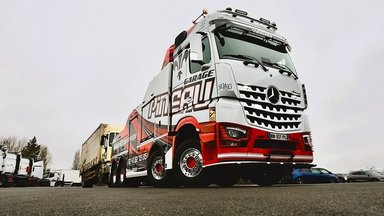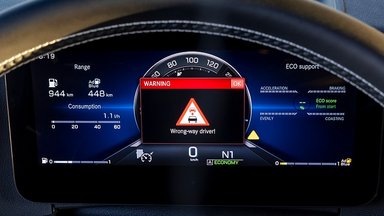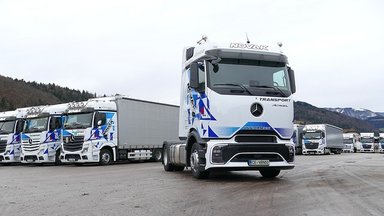
Split of Daimler into two independent companies: Daimler Truck transfers historical Mercedes-Benz commercial vehicles and archive to Wörth
Download

Split of Daimler into two independent companies: Daimler Truck transfers historical Mercedes-Benz commercial vehicles and archive to Wörth
Due to the split of Daimler into two independent companies on 1 December, Daimler Truck transferred the first batch of historical Mercedes-Benz commercial vehicles and parts of its truck and bus archive to the location in Wörth at the end of November. For this purpose a convoy of low-loaders and historical trucks and buses travelled from the Stuttgart area to the Application Information Centre (BIC) of the Mercedes-Benz truck…
Due to the split of Daimler into two independent companies on 1 December, Daimler Truck transferred the first batch of historical Mercedes-Benz commercial vehicles and parts of its truck and bus archive to the location in Wörth at the end of November. For this purpose a convoy of low-loaders and historical trucks and buses travelled from the Stuttgart area to the Application Information Centre (BIC) of the Mercedes-Benz truck plant in Wörth am Rhein. The historical trucks included a Mercedes-Benz LP 333 from 1960 (known as a “millipede” due to its two steerable front axles) and a Mercedes-Benz LP 608 which was the first truck produced at the recently opened Wörth plant in 1965. In future, Daimler Truck will mainly house its collection of historical exhibits near its truck and bus locations. Additional archival material and exhibits will be relocated in the weeks ahead.
Daimler Truck’s collection encompasses around 130 vehicles, of which about 30 were previously located in Stuttgart and the surrounding area. This collection also includes powertrains, parts and accessories from the company’s 125-year truck history. The archives of Daimler Truck were previously distributed on more than 160 square metres of storage space. The documents filled more than 2,000 metres of shelves on several levels. The archival material includes 2,600 rolls of film and 600 magnetic tapes that contain over 1,000 hours of historical moving images.
Sven Gräble, Head of Operations Mercedes-Benz Trucks, who is responsible for Mercedes-Benz Trucks’ global production network, welcomed the convoy when it arrived at the Wörth location. “Even though Daimler Truck will go its own way in the future, we and the car and van colleagues will continue to share a history full of pioneering spirit, a wealth of ideas and the courage to strike out in new directions,” he said. “I am delighted that we have found a new home for our historical commercial vehicles at our truck and bus plants. These wheeled witnesses to times past represent Daimler Truck’s 125-year history. In the future, they will be located right next to the manufacturing facilities for our future products.”
Mercedes-Benz Museum to remain the venue for the company’s shared history
Until now, the classic vehicles and the archive of Daimler AG have been centrally managed in Stuttgart. After the corporate split, the Group analogue archive for overarching, company-wide topics prior to the separation will remain in Stuttgart along with the archive for cars and vans. The Mercedes-Benz Museum in Stuttgart-Untertürkheim will continue to be the main publicly accessible location for the shared company history including trucks and buses.
Until now, the truck and bus exhibits have been housed at four main locations: the Mercedes-Benz Museum in Untertürkheim, the truck plant in Wörth, and two warehouses near Wörth and Stuttgart. Trucks and buses are also located at various other company facilities and as exhibition loans in a number of international museums.
Collection encompasses historic exhibits, a digital archive and future-oriented concept vehicles
The oldest collector’s item from Daimler Truck is an original Daimler Motor-Lastwagen from 1898. Another highlight is a replica of the first Daimler Motor-Lastwagen from 1896. The fastest exhibit is an Atego racing truck built in 2000. It has 1,500 hp and a top speed of 200 kilometres per hour. In addition to exhibits from the early days of commercial vehicle production, the collection also contains various future-oriented concept vehicles.
Employees from trucks and buses as well as those from cars and vans will continue to be able to use the digital archive in the future, as will historians, media representatives and other interested individuals. The digital collections concerning Daimler history that are of an overarching nature or that cannot be specifically attributed to one or the other company will be accessible through both of the two companies.
Overview of the first batch of transferred vehicles
Along with the archival material, the initial transfer also involved the transport of the following historical commercial vehicles from Stuttgart to Wörth: a Mercedes-Benz O 321 H panorama bus (1962), a Mercedes-Benz L 1500 with a wood gas generator (1937), Unimog 70200 No. 2 (Gebr. Böhringer, 1946), and a Mercedes-Benz OE diesel tractor (1926). These vehicles were transported by two Mercedes-Benz Actros and one Unimog U530 from the current product range of Mercedes-Benz Trucks. They were accompanied by a rally Unimog U400, which had been used as a service vehicle during the Paris-Dakar Rally in 2006.
Article assets

Split of Daimler into two independent companies: Daimler Truck transfers historical Mercedes-Benz commercial vehicles and archive to Wörth

Split of Daimler into two independent companies: Daimler Truck transfers historical Mercedes-Benz commercial vehicles and archive to Wörth

Split of Daimler into two independent companies: Daimler Truck transfers historical Mercedes-Benz commercial vehicles and archive to Wörth

Split of Daimler into two independent companies: Daimler Truck transfers historical Mercedes-Benz commercial vehicles and archive to Wörth

Split of Daimler into two independent companies: Daimler Truck transfers historical Mercedes-Benz commercial vehicles and archive to Wörth

Split of Daimler into two independent companies: Daimler Truck transfers historical Mercedes-Benz commercial vehicles and archive to Wörth

Split of Daimler into two independent companies: Daimler Truck transfers historical Mercedes-Benz commercial vehicles and archive to Wörth

Split of Daimler into two independent companies: Daimler Truck transfers historical Mercedes-Benz commercial vehicles and archive to Wörth

Split of Daimler into two independent companies: Daimler Truck transfers historical Mercedes-Benz commercial vehicles and archive to Wörth

Split of Daimler into two independent companies: Daimler Truck transfers historical Mercedes-Benz commercial vehicles and archive to Wörth

Split of Daimler into two independent companies: Daimler Truck transfers historical Mercedes-Benz commercial vehicles and archive to Wörth

Split of Daimler into two independent companies: Daimler Truck transfers historical Mercedes-Benz commercial vehicles and archive to Wörth

Split of Daimler into two independent companies: Daimler Truck transfers historical Mercedes-Benz commercial vehicles and archive to Wörth

Split of Daimler into two independent companies: Daimler Truck transfers historical Mercedes-Benz commercial vehicles and archive to Wörth

Split of Daimler into two independent companies: Daimler Truck transfers historical Mercedes-Benz commercial vehicles and archive to Wörth

Split of Daimler into two independent companies: Daimler Truck transfers historical Mercedes-Benz commercial vehicles and archive to Wörth

Split of Daimler into two independent companies: Daimler Truck transfers historical Mercedes-Benz commercial vehicles and archive to Wörth

Split of Daimler into two independent companies: Daimler Truck transfers historical Mercedes-Benz commercial vehicles and archive to Wörth

Split of Daimler into two independent companies: Daimler Truck transfers historical Mercedes-Benz commercial vehicles and archive to Wörth

Ulrike Burkhart
Spokesperson Mercedes-Benz Trucks Product, Service & eTruck
ulrike.burkhart@daimlertruck.com
+49 160 861 3757





















